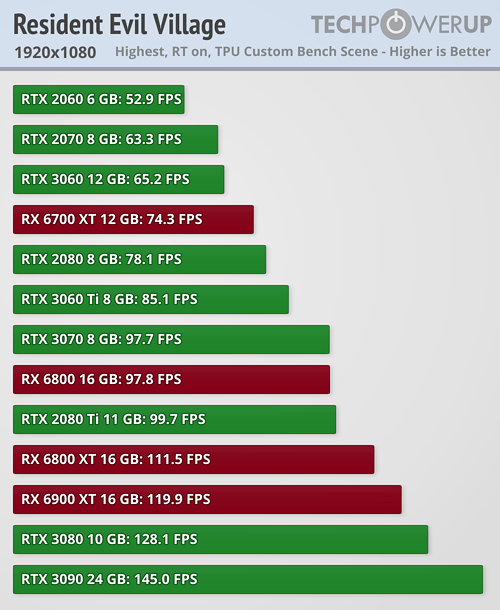 109
109
Resident Evil 8 Village Benchmark Test & Performance Review
Conclusion »Test System
| Test System | |
|---|---|
| Processor: | AMD Ryzen 7 5800X @ 4.8 GHz (Zen 3, 32 MB Cache) |
| Motherboard: | MSI B550-A Pro BIOS 7C56vA5 / AGESA 1.2.0.0 |
| Resizable BAR: | Enabled on all AMD RDNA2 & NVIDIA Ampere cards |
| Memory: | Thermaltake TOUGHRAM, 16 GB DDR4 @ 4000 MHz 19-23-23-42 1T Infinity Fabric @ 2000 MHz (1:1) |
| Cooling: | Corsair iCue H100i RGB Pro XT 240 mm AIO |
| Storage: | Crucial MX500 2 TB SSD |
| Power Supply: | Seasonic Prime Ultra Titanium 850 W |
| Case: | darkFlash DLX22 |
| Operating System: | Windows 10 Professional 64-bit Version 20H2 (October 2020 Update) |
| Drivers: | AMD: 21.5.1 Beta (21.10.01.17-RC1) NVIDIA: 466.27 WHQL |
We tested the press review version of Resident Evil Village. Both AMD and NVIDIA have released game-ready drivers for the game, which we used.
Graphics Memory Usage

Using a GeForce RTX 3090, which has 24 GB of VRAM, we measured the game's memory usage at the highest setting.
At the highest settings, the VRAM requirements are definitely noteworthy, but you're rewarded with excellent textures. Even at 1080p, we measured almost 6 GB. For 1440p and above, memory requirements should be no problem because all cards that can drive these resolutions have sufficient VRAM.
Once you turn on raytracing, memory usage is increased by roughly 1 GB. Not nothing, it still won't have a significant effect because cards today have plenty of VRAM.
GPU Performance



GPU Performance with Raytracing



FPS Analysis
In this section, we're comparing each card's performance to the average FPS measured in our graphics card reviews, which is based on a mix of 22 games and should provide a realistic average covering a wide range of APIs, engines, and genres.
Apr 26th, 2024 02:14 EDT
change timezone
Latest GPU Drivers
New Forum Posts
- What's your latest tech purchase? (20342)
- What phone you use as your daily driver? And, a discussion of them. (1483)
- Best SSD for system drive (81)
- AMD RX 7000 series GPU Owners' Club (1087)
- im new to throttelstop and i think i messed it up by copying others any hints would be very much aprreciated (3)
- Horizontal black lines popping up on my screen? (4)
- Which new games will you be buying? (316)
- Alphacool CORE 1 CPU block - bulging with danger of splitting? (20)
- Black screen after muting (5)
- What are you playing? (20530)
Popular Reviews
- Fractal Design Terra Review
- Thermalright Phantom Spirit 120 EVO Review
- Corsair 2000D Airflow Review
- ASUS GeForce RTX 4090 STRIX OC Review
- NVIDIA GeForce RTX 4090 Founders Edition Review - Impressive Performance
- ASUS GeForce RTX 4090 Matrix Platinum Review - The RTX 4090 Ti
- MSI GeForce RTX 4090 Suprim X Review
- Gigabyte GeForce RTX 4090 Gaming OC Review
- MSI GeForce RTX 4090 Gaming X Trio Review
- MSI GeForce RTX 4090 Suprim Liquid X Review
Controversial News Posts
- Sony PlayStation 5 Pro Specifications Confirmed, Console Arrives Before Holidays (117)
- Windows 11 Now Officially Adware as Microsoft Embeds Ads in the Start Menu (112)
- NVIDIA Points Intel Raptor Lake CPU Users to Get Help from Intel Amid System Instability Issues (106)
- AMD "Strix Halo" Zen 5 Mobile Processor Pictured: Chiplet-based, Uses 256-bit LPDDR5X (101)
- US Government Wants Nuclear Plants to Offload AI Data Center Expansion (98)
- AMD's RDNA 4 GPUs Could Stick with 18 Gbps GDDR6 Memory (88)
- Developers of Outpost Infinity Siege Recommend Underclocking i9-13900K and i9-14900K for Stability on Machines with RTX 4090 (85)
- Windows 10 Security Updates to Cost $61 After 2025, $427 by 2028 (84)